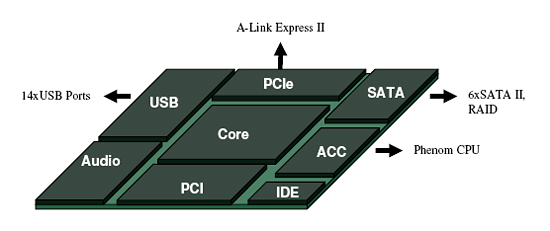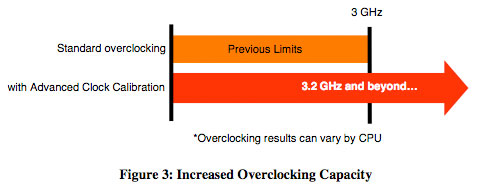SB750 Southbridge

While technically a new part, the SB750 appears to us to be a point upgrade to the SB700. However, it is a major improvement over the SB600. Anyway, let’s get into what has changed and what has not.
The SB700/750 features six SATA 3.0Gb/s ports, up from four on the SB600, with the ability to reserve up to two of those ports for eSATA connectivity. AHCI performance and setup is much easier now and we have not experienced the same problems that plagued the SB600. Drives can be set up in RAID 0, 1, or 10 and RAID 5 now makes its appearance in the SB750. RAID 5 works well for a host based controller and even outperforms the ICH10R in early testing with a three drive array, but four or more drives is resulting in some odd behavior that we are trying to figure out now.
Still missing in action is a native interface for networking support. AMD continues to use an external PHY and MAC for network operations. Although performance is similar to the NVIDIA and Intel solutions, this setup does incur a cost penalty for the motherboard suppliers.
The major improvement in the SB700/750 series over the SB600 is the increase in USB 2.0 performance and the number of ports available. The new dual-channel controller features 12 USB 2.0 capable ports and 2 specific 1.1 ports for compatibility reasons. USB 2.0 performance is up to par with the Intel and NVIDIA solutions.
A single PATA channel provides native IDE support for up to two drives. This channel supports PIO, multi-word DMA, and Ultra DMA 33/66/100/133. Six PCI lanes are still included although we doubt a board manufacturer is going to offer that many. AMD dropped HyperFlash support on the SB700 to make way for the new Advanced Clock Calibration interface.
The SB700/SB750 features four PCI Express lanes for the A-Link Express II interconnect between the Northbridge and Southbridge, but like the current 790FX/780G series, those four lanes are based on PCI Express 1.1 specifications. That means the interconnect bandwidth is capped at 2GB/s, half of what it would be in a PCI Express 2.0 configuration.
Finally, we have the High Definition Audio controller carried over from the SB700 that allows up to 16 channels of audio output per stream. The controller supports up to four codecs with sample rates reaching 192kHz at up to 32-bits per sample.
ACC-

The most drastic and perhaps most important change on the SB750 is the new Advanced Clock Calibration interface that promises additional overclocking headroom or lower voltages with the Phenom processor series, especially the BE products. We have seen clock improvements ranging from 100MHz to over 500MHz depending on the processor we utilized.
The SB750 now has a direct 6-pin interface to the AM2+ socket on the motherboard, there are now pins on the Phenom CPU that connect directly to the SB750. These pins were previously unused and are now used as a means of communication between the South Bridge and the CPU. The SB750, in combination with an updated BIOS, can now override some of the CPU's internal settings which can potentially increase the overclocking headroom of the chip.
AMD says that the settings tweak doesn't impact performance and doesn't change thermals or voltages, it simply can allow a Phenom processor to clock higher when overclocking. The BIOS exposes the parameter being changed, which AMD refers to as the Advanced Clock Calibration (ACC) value. Typically this value has a range of -2 to 0, on motherboards with the SB750 that support ACC the value can be set from -12 to +12. Higher numbers should allow for higher clock speeds, while lower values should allow for lower voltages/lower power operation.
Even after a full press court for the last three weeks, AMD will not tell us what this value actually adjusts - simply stating that it makes it easier for the CPU to run at higher speeds. Based on AMD's careful choice of words, it would seem that adjusting the ACC somehow changes the acceptable margins of operation for the CPU cores (the value can be changed on a per-core basis in AOD or BIOS). By loosening these margins, however it is able to do so; the SB750 + ACC combo can enable many Phenom processors to operate outside of their normal overclocking margins. In fact, AMD is confident enough about the technology that they are willing to state publicly that on average; a 100MHz to 300MHz increase in clock speeds is attainable by the user after some tweaking. In fact, we totally agree with these numbers after extensive testing.
The SB750/ACC trick doesn't work on anything other than Phenom processors, and it works particularly well on the Black Edition processors. While AMD didn't rule out eventually enabling this on K8 based cores, it is a Phenom-only option for now. Reaching higher clock speeds is more of a top priority for Phenom, and it's unclear whether or not whatever AMD is doing here can even work on K8 if they tried.
AMD also committed to enabling similar tweaks for upcoming 45nm based Phenom parts, implying that this was not a short-term solution to the clock speed problem. At the same time, AMD implied that the tweaks that the SB750/ACC feature enables could be incorporated into the manufacturing chain and actually implemented in hardware.
Microprocessors are designed to operate in even the most extreme of conditions, AMD seemed to imply that its ability to adjust the ACC value somehow changes this. Curiously enough, AMD cited "competitive concerns" as a reason why it would not disclose exactly what's going on with this new overclocking feature. We still cannot help but wonder if it is because AMD is going a little too far in the sacrifices, it is willing to make in the quest for higher clock speeds.










39 Comments
View All Comments
flipmode - Wednesday, August 6, 2008 - link
What does underrated mean - that the Phenom hasn't been given the credit it is due? That's pretty much what it sounds like, and if that's the case then, isn't that ball in you guys' hands?flipmode - Wednesday, August 6, 2008 - link
gah! the quote button didn't work. my above post was supposed to start with this quote:"That brings us to what we see as the jewel of this product release, the SB750. It brings sorely needed overclocking headroom for the underrated Phenom processor"
Calin - Thursday, August 7, 2008 - link
In this case, I think underrated means "rated at an inferior clock speed"ZootyGray - Tuesday, August 12, 2008 - link
it means it should be rated higher - but due to bias, market manipulation, and the gullibility of the general public - not to mention deliberate choice of test conditions designed to make look bad, unbeknownst to the gullible public, or deliberate intent to just emphasize all problems with little or no basis in fact - etc etc etc- and then delays and other self-important indulgences.
Opposite to overrated. Result of market hype - a belief that the usual is superior when it has already gone flat.
You know there are test reports all over the internet.
MikeODanyurs - Wednesday, August 6, 2008 - link
What's the word on the AMD OverDrive 2.1.2 release?Ephebus - Saturday, August 9, 2008 - link
They can't even get a simple utility like AMD Power Monitor right, so I wouldn't expect much if I were you. AMD Power Monitor won't report the cores' clocks correctly anymore if the processor is overclocked - it shows the values as if it wasn't overclocked. The last version that worked OK with overclocked processors was version 1.0.2. There have been 3 releases since that version, and I've complained to AMD every time a new release would come out that the utility had stopped working correctly. Then finally some AMD guy said he tested it under Vista and it worked OK, but not under XP. Maybe they are not aware of all the people who won't touch Vista with a ten-foot pole? I was really disappointed by this kind of "support" and pretty much gave up on AMD. I've been buying inferior processors from them just to support the company (yes, I'm that idealist), but in my next upgrade I'll go Intel all the way.ZootyGray - Tuesday, August 12, 2008 - link
I don't believe anything you say. Your problem is not AMD's fault - is it?And do you suppose we should assume that an antitrust busted monopolist will babysit and care for us all?
If so, you would probably put me in charge too - right? Careful.
Ephebus - Thursday, August 14, 2008 - link
The utility is made by AMD for AMD processors, so yes, it is AMD's fault, fanboy.